Don’t Skip These 9 Specific Steps to Get More Attendees to Your Virtual Events

Maximize Your Marketing ROI
Join 10,000 other marketers already getting the best tips on running engaging events that boost pipeline and create raving fans.
Getting more virtual attendees to your online event is every event marketers’ reason for being—but with the rise of virtual-fatigue, attracting the same numbers you’re used to seeing at in-person events is becoming harder every day.
From jarring stop-start sessions to a lack of branding options, event marketers have dealt with some major obstacles as they were forced to dive head first into the world of virtual event marketing—and it’s those key details (or lack of) that can deter attendees from signing up.
But it doesn’t have to be this way.
There are a ton of customized virtual event tools, tips and pro tactics that can help you build the type of buzzworthy online events attendees just won’t miss.
But before we dive into how to promote a virtual event it, let us be clear about one thing: Well-attended events are just one piece of the go-to-market puzzle.
Michelle Cogliano, Director of Field Marketing and Events at SecureAuth has some wise words on this very topic:
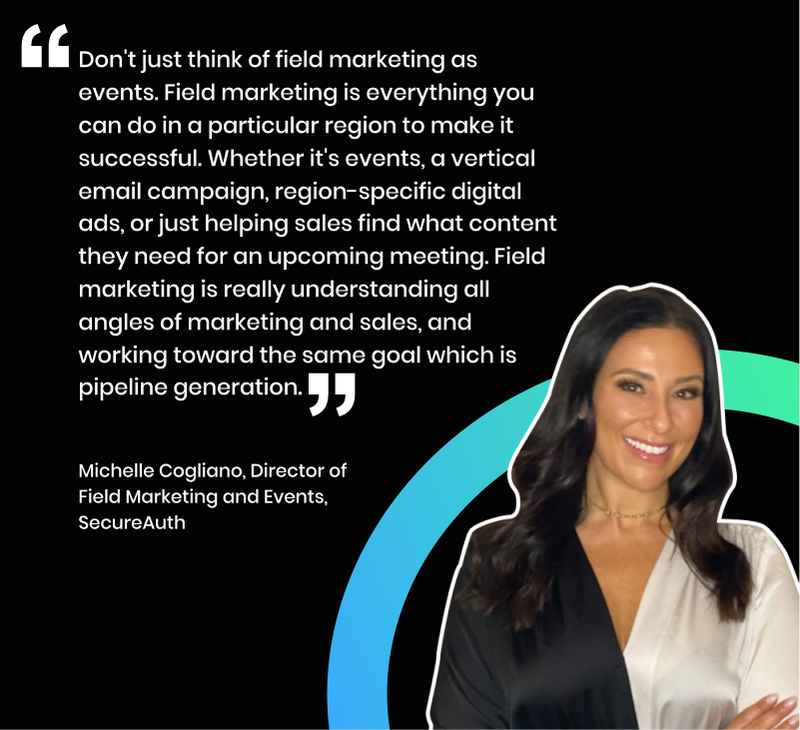
In this ultimate field marketer’s guide to boosting your attendee numbers, we’ve pulled together a step-by-step checklist showcasing exactly what to do before, during, and after the event to attract and keep virtual event attendees every time.
How to get more attendees to your next virtual event
1. Top 10 tactics to get (and convert) more virtual event attendees
2. Before the event
- Know your market
- Drill down on your KPIs
- Show some personality
- Make promotion easy breezy
3. During the event
- Stream a Netflix-worthy event
- Engage, engage, engage
4. After the event
- Make attendees feel special
- Reach out to non-attendees
- Drill down on data
5. Getting attendees through the door: The devil’s in the detail
Top 10 tactics to get (and convert) more virtual event attendees
Before we get into the details, let’s look at the top tactics to kickstart your attendee roll-in.
Take some time to think intentionally about which of these tactics make the most sense for your brand based on your pre, during and post event planning strategies.
💡Connect with local industry reps to get to know your audience and start building buzz.
💡Develop event content based on audience’s *real* needs.
💡Run digital media ads to reach new and bigger audiences.
💡Make sure there’s an option to add the event straight into their calendar.
💡Send attendees physical gifts or merch to keep your event top-of-mind.
💡Send value-first reminder emails three days before the event, the day before, and 10 minutes before.
💡Get partners involved to create a wider offer to participants, and take advantage of their audience base.
💡Make it easy for account managers and account executives to drive event attendance with done-for-you promo emails and templates.
💡Always add an interactive social element to your event like a cooking lesson, wine tasting, or prize draw.
💡Provide a specific timeline to keep account managers and account executives engaged, organized and actively promoting the event.
Before the event
Before you send the invites and watch those attendee numbers roll in, there’s a lot of planning to do.
From knuckling down on your goals, to building an event brand that reflects your audience’s needs, everything you do before the event will have a huge impact on how many people actually turn up.
But before we dive into the details, here’s one key formula to remember:
Your company goals (why) + Your audience’s needs (who) = An unmissable event (what + how)
Let’s break this down:
- Company goals: This is the why of your event. Before you do anything, you need to get clear on this specific event’s purpose for being by providing a direct reason for attending. For example, if your company goal is to close more enterprise accounts for your cybersecurity software, you might choose an event theme focused oncertainty and stability.
- Audience needs: This one is all about who your event is for. Before you can attract the right attendees, you need to know everything there is to know about the specific buyer persona you want to target. After all, the surest way to get more attendees is to build an event they actually want to go to (more on this in a minute 😉).
- The perfect event: Once you know why you’re running it and who it’s for, you have everything you need to build a well-attended virtual event (the what). Now it’s just about implementing some practical steps (the how) to put it all into practice.
Ready? Let’s dive into those details.

1. Know your market
Getting to know your audience is easier said than done—it takes dedication and a ton of research. But the results are so worth it and can help you create virtual events that grab (and keep!) your attendees’ attention.
Here’s how it’s done:
- The audience overview: Your company already knows its key audiences. For example, a company offering an HR system will be selling to HR pros and business leaders.
- The attendee persona: You’ll need a detailed breakdown of exactly who you want to attend your event, what they do, and what their daily challenges are, etc. In the HR example, it could be a talent director with X-years’ experience, who reports to the CHRO and manages a team of up to 10 people, but struggles to keep their systems streamlined.
- The attendee data: This is where it gets really interesting. By measuring audience attendance and behavior from previous events, you can get right under the fingernails of your attendee persona and find out what really makes them tick. For example, if you ran a previous event where several attendees asked questions about hiring, you might want to create a new event focused entirely on those specific recruitment questions so you can provide the answers and support attendees need.
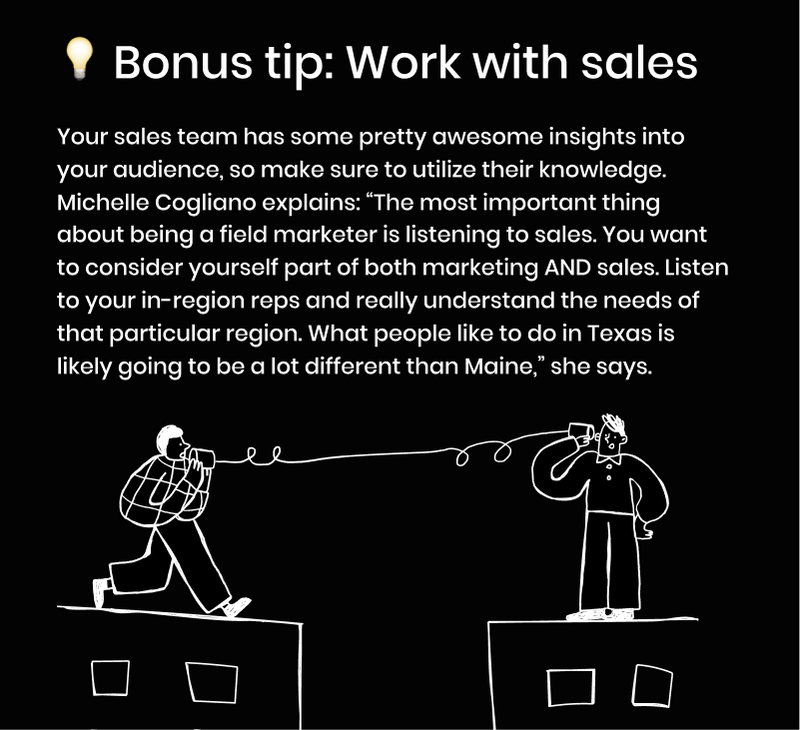
2. Drill down on your KPIs
This next step is all about focusing on your event goals.
Because while high attendee numbers are a beautiful thing, your event Key Performance Indicators (KPIs) go a level deeper to outline exactly which metrics to watch and help keep your events actionable and revenue-friendly by giving you and your sales team solid data to move on in your post-event plans.
The right event KPIs help you:
- Build a solid attendee-behavior database to inform future sales decisions
- Pinpoint event strengths and weaknesses to improve future events
- Prove your event value and claim your seat at the revenue table
These are just some of the metrics you should be ready to track from day one:

Other event metrics to look out for:
- Account level insights (prospects)
- Account level insights (customers)
- Velocity through pipeline
- Closed-won opportunities
- Closed-won revenue
The event metrics you choose will ultimately come down to your current revenue strategy and the specific attribution model you’ve chosen for your event. Is this a demand gen event geared towards casting a wider net at the top of the funnel? Or an account-focused event aimed at evolving key relationships?
Keep in mind that you can also take data gathering one step further to make even your qualitative data actionable.
For example, if you measure what questions attendees ask, you can tally up how many people asked what type of questions to create a custom engagement score and arm your sales team with a hyper-personalized follow up strategy.
3. Show some personality
Better branding attracts better business—but as every great marketer knows, there’s way more to it than just adding your logo to your landing page. Getting it right is all about being laser-focused with your event branding decisions.
Here’s how to create event branding that attracts the right attendees:
- Think goals and audience: Your virtual event brand should be customized to match your company’s goals and audience. Remember when we talked about knowing your market? This is yet another stage where that comes into its own.
- Consistency is nine-tenths of the law: Consistent branding across all your company channels can boost revenue by almost 25%, so it’s no surprise this is key to building a solid event audience.
- Choose a customizable virtual event platform: You’ve created killer event branding, now you need somewhere awesome to showcase it. Ditch the out-of-the box options everyone else is using and pick an event platform that allows for full customization so you can show your attendees that your brand always goes the extra mile.
- Send something personal: Depending on your event theme and budget, you’ll definitely want to send some awesome direct mail to your registrants in order to help boost attendance on the big day. Choose fun, tangible items that are hard to ignore and make sure you set a solid sending cadence that will keep your brand top-of-mind in the weeks and days leading up to the event.
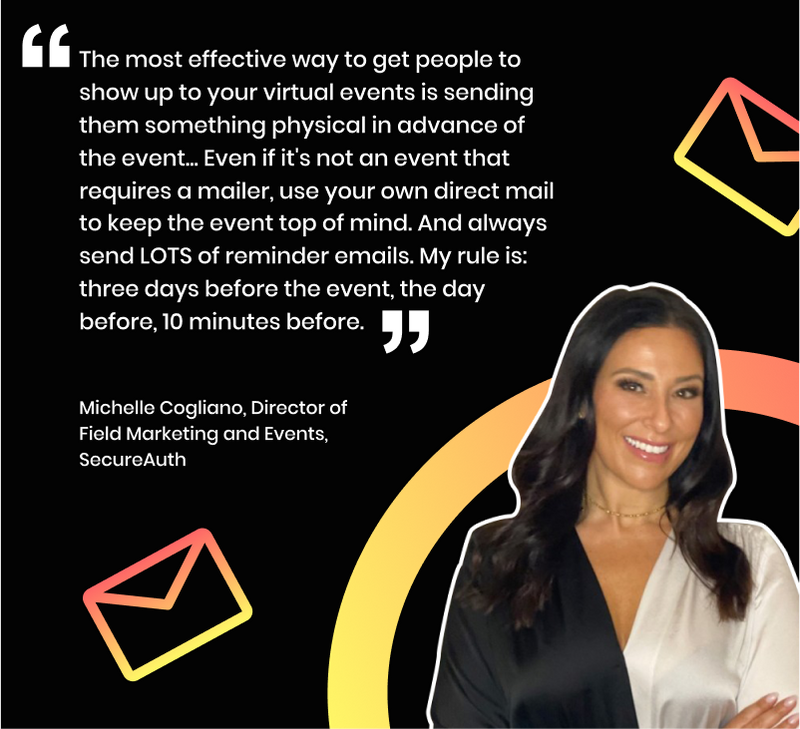
Alex Yoder, Field Marketing Specialist at Lessonly is a big believer in kicking off attendee engagement long before the actual event.
“Increased communication and focusing on unique experiential touches has definitely helped increase our event attendance,” says Alex.
“Before each event, we always send some sort of event supplies—this could be wine for a tasting, painting materials for a class, or ingredients for a cooking class. We also send emails introducing everyone, asking ice breaker questions, and allowing registrants to connect on LinkedIn. This gives everyone a chance to get to know one another before the event.”
4. Make promotion easy breezy
In the age of Zoom-fatigue, successful virtual event promotion is tough.
Field marketing experts like Alex know just how hard it can be: “Driving registration for events can be a challenge! Another hour staring at a screen? It's hard to promote,” she says.
But as a determined event marketing pro, Alex has a solution:
Make your event promo as easy as possible for your account managers.
“We utilize our account managers and account executives to drive all the event attendance. Making this process as easy as possible on them is key. For each event we package all promotional materials together—email templates, slides, specific links, landing pages, etc, and hand it off to our teams. We host pre-event syncs and send post-event wraps ups. Laying out a specific timeline and keeping them organized is key for successful event registration,” she explains.
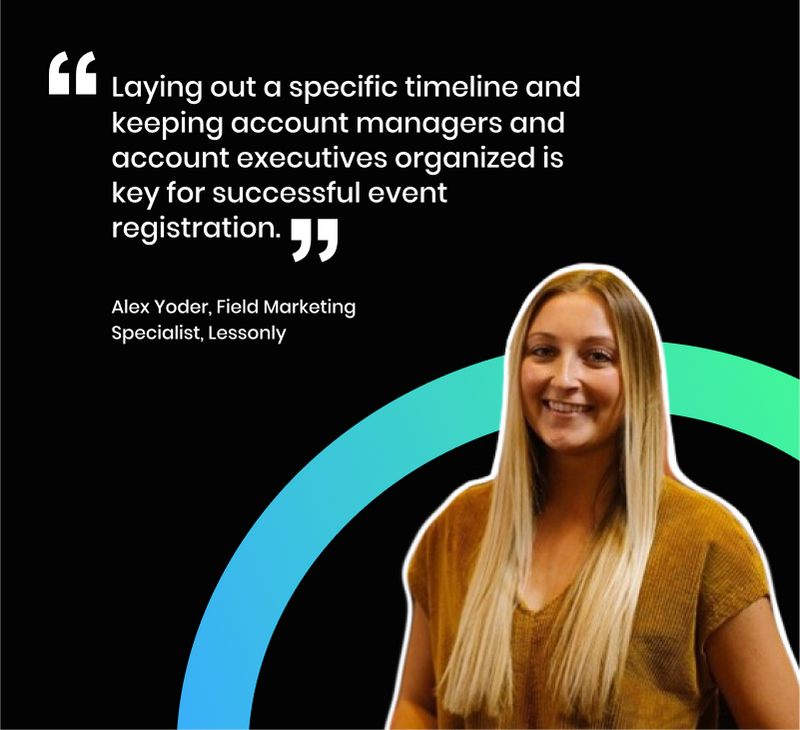
During the event
Congrats! All your planning work has paid off and you’ve got a ton of super-engaged attendees walking through the (virtual) door. 🙌🏻
Um, hate to tell you this but... the work’s not over yet.
You need to make sure this event goes off without a hitch and your attendees have the time of their lives. If it works, they’ll be back for more and you’ll be known for hosting epic events people actually want to be a part of. Here’s how to make that happen during the event.
5. Stream a Netflix-worthy event
Gone are the days of clunky stop-start sessions—with the right tools, you can stream live and pre-recorded videos as effortlessly as Netflix.
These are the streaming features to look for next time you choose a smart virtual event platform:
- Mix and match live and pre-recorded videos: The great thing about virtual events is that if your speakers can’t make the date, they can pre-record videos and show their faces anyway. The right virtual event tool will allow you to run these pre-recorded videos seamlessly alongside live sessions, so your attendees barely notice the difference.
- Make viewing easy: Great tools will allow you to organically nudge attendees into different sessions, so they don’t have to lift a finger and your speakers and sponsors can benefit from guaranteed traffic.
6. Engage, engage, engage
Audience engagement is mission-critical to successful virtual events.
Research shows organizations that don’t attempt to engage virtual event attendees are 150% more likely to be unsuccessful.
The secret? Build engagement into every stage of your event, from in-session polls to live networking.
“Always include an interactive element in your event strategy,” says Noelle Peterson, Global Events Marketing Director at UserTesting, “Attendees are craving that human interaction and being able to network with their peers is essential.”
Here are a few simple ways to create awesome attendee engagement:
- Break-out rooms
- Networking sessions
- Live on-stage questions
- Live chats
- In-session polls
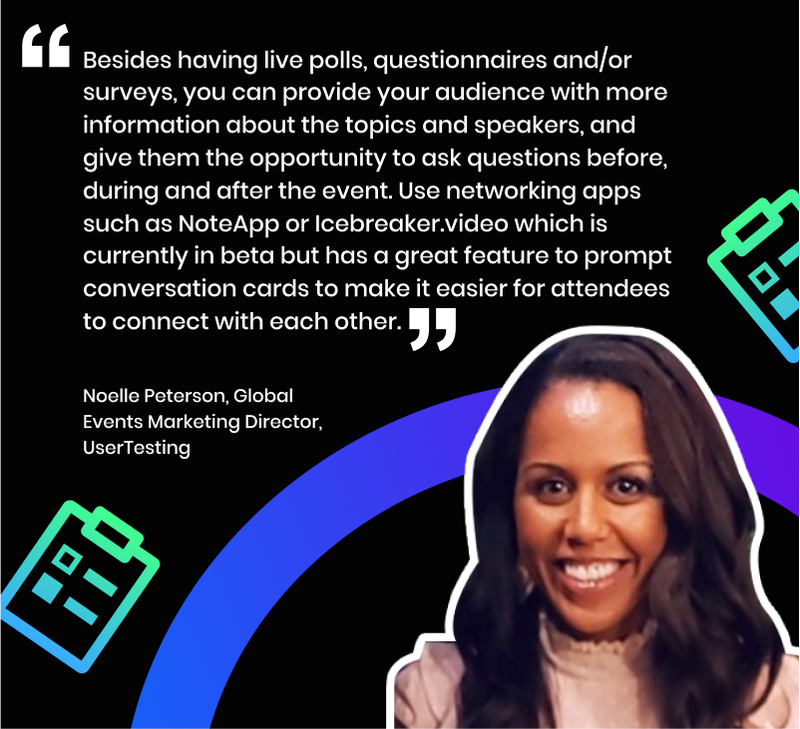
After the event
Phew! You’ve done great. Your attendees left the event feeling inspired and full of good thoughts.
Time to put your feet up? Not yet—because what happens post-event is probably the most important stage of the entire process.
Here’s why:
- This is your chance to find out some key feedback about the event to help you improve next time.
- You need to follow-up with your key accounts while they’re still raving about your event.
- The days after the event present a golden opportunity for marketing and sales to work side-by-side to finally close-win those all-important accounts.
7. Make attendees feel special
Here at Goldcast, we talk about the importance of great follow-up a lot.
How you interact with your key accounts post-event is just as important as engaging with them on the day and can make or break the outcome of your event.
Here are a few simple steps to make the most from all your hard work:
- Share key account-level insights with sales. Here’s a quick list of what to include:
- Average time spent in the event
- Sessions attended for each attendee
- Average time spent in each session
- Content/resources downloaded during each session
- Questions asked
- Polls completed
- Calculate a Total Engagement score based on these insights (if you’re a Goldcast user, we’ll do this for you automatically).
- Schedule event follow-up templates and emails. Okay, so this is one you’ll want to do pre-event, but it’s after the event that your scheduled emails should be loaded up, customized, scheduled and tracked.
- Follow your post-event strategy. Think: What are the key post-event actions marketing/sales need to take? What is the goal, timeframe, and priority level for each?

8. Reach out to non-attendees
No matter how awesome your outreach was, not everyone will attend your event.
But that’s okay, because you can learn as much from the no-shows as you can from those who turn up on time and in tune.
For the accounts that were invited but never showed up, an automatic email with a quick poll asking them why they didn’t come will help pinpoint your weaknesses so you can strengthen them for next time.
9. Drill down on data
You’ve planned, promoted, and run an awesome event that everyone’s talking about—congrats!
Now it’s time to collate all your data in one place.
User Testing’s Noelle Peterson explains: “Getting qualitative feedback from event attendees is incredibly important. The feedback, insights and opinions of attendees will help make your next virtual event even better. Knowing what your target audience likes, dislikes, wants and needs while planning, you’ll be able to develop an event and content that is focused on the right topics and you'll see virtual attendance rates and engagement rise and stay high.”

With Goldcast, you can track every inch of audience behavior throughout your event, and review the data all in one visual dashboard post-event.
Getting attendees through the door: The devil is in the detail
Great attendee experience makes the virtual event world go around. 🌎
From creating a customized online event marketing and promotional plan to ensuring attendees feel special at every turn, there are a million and one ways to utilize exceptional virtual event tools to create the ultimate attendee experience.
As long as you build a solid toolkit, focus on personalized engagement, and keep your data hat on at all times, you’ll be known for hosting the greatest virtual events in no time.
Stay In Touch
Platform
Resources
Company
Community
© 2024 Copyright Goldcast, Inc. All rights reserved.